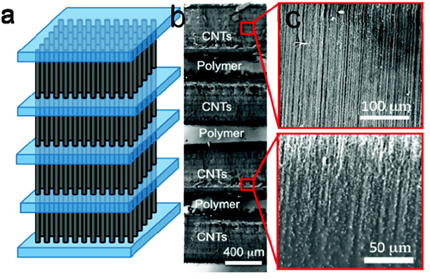Carbon nanotubes (CNTs) have demonstrated unique mechanical properties similar to those found in various fibrous materials, exhibiting excellent compression capability combined with extreme structural flexibility and recovery from mechanical deformation. As such, arrays or forests of vertically aligned CNTs have been considered for ultra-light weight shock absorbing material. In addition, CNTs incorporate multifunctional properties, including excellent electrical and thermal conductivity. These properties then allow layers formed for energy absorption to monitor in situ strain loading. The utilization of vertically oriented CNT arrays for mechanical energy absorbing benefits from fundamental understanding of stress wave mitigation ad deformation mechanisms in fiber reinforced composites or porous foam-like materials where layered structures of materials have been adopted for shock and vibrational damping. As weight reduction is an important feature of incorporating such materials having advanced multifunctional properties for practical impact protection, multilayer CNT arrays represent a viable candidate for such applications. For practical implementation, as-grown CNTs by chemical vapor deposition (CVD) tend to exhibit a softer base, and thus are more prone to buckling and deformation, making them excellent candidates for energy absorbing materials. Previous approaches to multilayer arrays incorporating vertically aligned CNTs on metal foils or other inorganic layers have shown some improvements in energy absorption properties, yet remain limited as a result of the weak adhesion of the CNTs to the substrate.

Characterization of the multilayer structure under quasi-static and dynamic loading demonstrated the energy absorbing capacity of the materials exhibiting foam-like properties. The structures were able to sustain large compressive deformations up to ~0.8 strain, exhibiting nearly complete recovery. The structures reached a steady state response to the compression after the first two cycles, suggesting that any irreversible damage to the structure occurs during the first couple deformation cycles. Additionally, it was observed that the electrical conductivity of the vertically aligned CNT arrays increased after the first couple compressive cycles, suggesting a rearrangement of the CNTs within each array. The energy absorbing properties for the polymer-CNT multilayer architecture were estimated to be at least three orders of magnitude larger than that of natural and synthetic cellular foam materials having comparable densities. Thus an innovative method to create multilayered, hierarchical structures of polymer-CNT foams has been demonstrated, providing unique properties for impact and vibrational protection applications.
Reviewed by Jeff Morse, PhD, National Nanomanufacturing Network
- Misra A, Raney JR, De Nardo L, Craig AE, Daraio C. 2011. Synthesis and characterization of carbon nanotube-polymer multilayer structures. ACS Nano. 5(10): 7713-7721. http://dx.doi.org/10.1021/nn202262j
Figure reprinted with permission from Misra A, Raney JR, De Nardo L, Craig AE, Daraio C. 2011. Synthesis and characterization of carbon nanotube-polymer multilayer structures. ACS Nano. 5(10): 7713-7721. http://dx.doi.org/10.1021/nn202262j. Copyright 2011 American Chemical Society.
